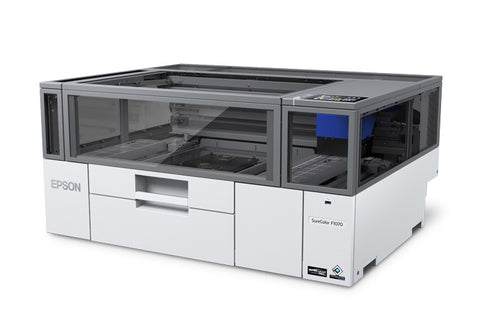DTG (direct-to-garment) and DTF (direct-to-film) are both digital printing methods that work well for customizing garments.
The main difference is that DTG printers print directly onto a piece of fabric, while DTF printers print onto film that’s transferred onto an item with a heat press.
That’s DTG vs DTF in a nutshell, but keep reading to understand the ins and outs of both printing types and decide which is best for your customization business! 👕
🎤 Who are we and why are we qualified to talk about this?
We’re an Epson-certified distributor and have a lot of experience with printers! 🖨️
We’ve helped thousands of craft and customization businesses find the right equipment, and we’re here to help you do the same.
(And, spoiler alert: There’s an affordable, beginner-friendly printer that can do *both* types of printing! Skip to the end for more info 👀✨)
Here’s what we’ll cover:
- DTG vs DTF: What’s the Difference?
- What is Direct-to-Garment Printing?
- What is Direct-to-Film Printing?
- This Printer Does Both!? Introducing the Epson SureColor F1070
- Final Thoughts
- Frequently Asked Questions (FAQs)
DTG vs DTF: What’s the Difference?
As we mentioned at the beginning, DTG and DTF are both printing methods that work well for garments.
They both print with white ink, so prints show up beautifully on dark surfaces.
And they both print on natural fabrics like cotton, so they’re great for t-shirt businesses.
Compared to screen printing, these printing methods are both good for smaller batches or one-off prints because you don’t need to prepare stencils.
They also make it easier to print custom designs because all you need to do is load the image on your computer and click Print! No layering of stencils or vinyl stickers needed.
A disadvantage of these methods is that they require regular maintenance to keep the printers in working order. It’s best to print regularly to keep the ink from drying out and clogging the printer.
They also cost more than a simple desktop or sublimation printer, but it all depends on how much you plan to invest in your business and how you plan to earn revenue to cover the cost of the printer.
To summarize:
- Both work well for garments, dark materials, and natural fabrics
- Both work well for smaller batches or one-off prints
- Both make it easy to print custom designs in one go
- Downside: You must maintain these printers and print regularly
- Downside: These printers cost more than your standard inkjet or sublimation printer, though it could be a good investment for your business!
Besides that, these two methods are very different!
Let’s look at the pros and cons of each type.
Advantages of DTG
- Prints can feel very soft, almost like they’re not there
- Doesn’t require transfer paper
- Works with 100% cotton
Disadvantages of DTG
- Prints on flat surfaces only
- Can’t print transfers in advance to save time
- Requires pretreatment of fabrics
- Doesn’t handle transparency well
- Doesn’t work with synthetic materials or other surfaces
Advantages of DTF
- You can sell transfers or store for later for more efficient printing
- Can print multiple prints on one sheet
- No pretreatment necessary
- DTF uses less ink, so you may save money over time
- Works on all kinds of materials and surfaces, including shirts, hats, shoes, tumblers, glass, wood, cotton, polyester, and more
- Can handle transparency in printed images
Disadvantages of DTF
- You need to add a powder adhesive and cure before pressing, which can get into the air and be very toxic (so proper safety precautions are necessary)
- Requires the step of printing onto paper and then pressing later with a heat press
- Can leave a shiny surface on the garment that’s not as soft as DTG
So these are the main points you should know when considering buying a DTG or DTF printer.
(By the way, if you’re not up to maintaining a printer regularly or investing in a higher-cost printer, you might want to consider sublimation printing as a better alternative for your customization business.)
Read More: DTF vs Sublimation Printing: Which Is Right For You?
What is Direct-to-Garment Printing?
Direct-to-garment (DTG) printing is a printing method that prints digital images directly onto flat shirts or garments using water-based ink.
You pretreat the fabric and cure it with a heat press before printing. (Or buy a pre-treated shirt.)
Then you load the garment onto the printing surface (called a platen) and print the image. The image prints the white ink layer first, then prints the colors to create the final image.
Finally, you press the printed image with a heat press to cure it and get it ready for wearing and washing.
Get started by reading our deep-dive guide to DTG printing.
What is Direct-to-Film Printing?
Direct-to-film (DTF) printing is a printing method that prints digital images onto special film which can be applied to almost any surface with a heat press.
First, you print the image onto DTF film using a DTF printer and DTF ink.
The image prints in reverse, colors first, then white.
Then, while the ink is still wet, you shake adhesive powder over the entire image and cure it with a heat press to create a transfer.
This can be applied to practically any surface and any color background with a heat press.
Get started by checking out our in-depth guide to DTF printing.
This Printer Does Both!? Introducing the Epson SureColor F1070
Yup, you read that right!
Epson’s new SureColor F1070 printer is an entry-level DTF and DTG machine, all rolled into one!
It’s perfect for someone new to these printing methods or a small to medium-sized business owner who wants to expand their business.
That means you don’t have to choose! 👏
Here are the main stats for this printer:
Pre-Order the Epson SureColor F1070 *Expected to ship in May 2024*
(Or learn more in our guide to the SureColor F1070.)
Final Thoughts
More Americans are buying custom t-shirts every year.
Within that growing market, the share of t-shirts printed digitally (including with DTG and DTF) is expected to grow by 12% every year until 2030. 💡
Now’s a great time to get in on this trend as more people look for personalized shirts and garments reflecting their personalities and interests.
What do you think?
Are you planning to get the Epson F1070 or another digital printer? Do you have any more questions for us?
💬Leave us a comment and let us know!
Before you go, check out our Official MakerFlo Facebook Community where you can meet other crafters and ask for their opinions, too.
And join our mailing list to get notified when we publish more content like this 👇
Frequently Asked Questions (FAQs)
Which printing method is better for dark fabrics?
They both use white ink, so both work on dark fabrics. It depends on the type of fabric you’re using and the type of garment. If it’s 100% cotton and flat, DTG should work well if you pretreat it first. If it’s any other kind of material or not flat, DTF is probably a better option.
Which is better for t-shirts, a DTG or DTF printer?
Both work well. DTG can leave a soft feel on 100% cotton shirts, while DTF transfers can feel a little bit more like a decal, though they last longer.
Which printing method is better for printing on hats?
DTG printers print on flat surfaces, so for hat printing, you’ll want to use a DTF printer to make a transfer, then apply it with a hat press.
How do DTG and DTF compare to screen printing?
Both DTG and DTF are great for small businesses, small print batches, and one-off personalized prints. Screen printing is better for commercial printing companies and larger batches because you need to make a stencil for each design.
Also, because screen printing is done by layering stencils, you have to use blocks of color and place the stencils correctly each time. On the other hand, DTG and DTF make it easy to print intricate designs straight from a design program.
For commercial printing and bulk orders, however, screen printing is not only faster but also more cost-effective over time. It also gives you more variety of fabrics and effects you want to create with ink. And it tends to last longer than DTG and DTF-customized items.
How do DTG and DTF compare to sublimation?
Sublimation prints work best on white or light-colored polyester materials. DTG works on all colors and natural fabrics, and DTF works on all colors and practically all fabrics and materials.
Like DTF, you print a sublimation transfer and then apply it to the object, so it’s similar in that way.
Entry-level sublimation printers are more affordable than DTG and DTF printers, and they’re easier to maintain.





















